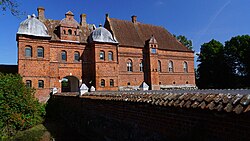Jacob Brønnum Scavenius Estrup
Jacob Brønnum Scavenius Estrup | |
|---|---|
Christian Frijs | |
| Preceded by | Frederik von Tillisch |
| Succeeded by | Wolfgang von Haffner |
| Personal details | |
| Born | 16 April 1825 Sorø, Denmark |
| Died | 24 December 1913 (aged 88) Kongsdal, Denmark |
| Political party | Højre |
| Spouse | Regitze Holsten |
| Children | 1 |

Jacob Brønnum Scavenius Estrup, (16 April 1825 – 24 December 1913), was a
From a Danish historical perspective, he is perhaps most famous (or infamous) for the so-called provisional time (provisorietiden) from 1885 to 1894. After a huge defeat in the 1884
Biography
Estrup was son of the landowner and headmaster at Sorø Academy Hector Frederik Janson Estrup (1794–1846) and Jacobine Scavenius (1800-1829), daughter of Jacob Brønnum Scavenius (1749–1820).[4]
He inherited the estate Kongsdal in
As Interior Minister in the Cabinet of Frijs, Estrup took control of the railroads of Jutland and Funen, which had been ceded to an English consortium in 1861. He expanded the railroads in Vendsyssel and built new lines from Skanderborg to Silkeborg and along the west coast of Jutland to Esbjerg, earning him the nickname "Railway Minister". He also built up the harbour in Esbjerg, which turned into an important center for exports. In 1869 he was forced to step down from his post because of health problems.[7]
In 1875 Estrup was able to replace
When an assassination attempt failed on 21 October 1885, Estrup responded by passing various laws restricting the press, restricting the right to own arms, and broadening the powers of the police. In 1894, Venstre and Estrup's Højre cooperated to pass a budget bill, and Estrup resigned. He would not hold any future offices as a minister but retained significant influence in the following governments formed by Højre.
Personal life
He was decorated with the Order of the Elephant in 1878 with conferring rank of Grand Cross Knight of the Order of the Dannebrog and Dannebrogsmand. He was married in 1857 to Regitze Holsten-Charisius (1831-1896), daughter of Adam Christopher Holsten-Charisius. They were the parents of six children. Estrup died on Christmas Eve 1913 in Kongsdal and was buried at Undløse Church.
References
- ^ Peter Ilsøe & Johs. Lomholt-Thomsen, "Norden Historie 2, 1864-1964" , Published by Gyldendalske Boghandel, Nordisk Forlag A/S, Copenhagen in 1965, (no ISBN), page 34
- ^ "Estrup, Jacob Brønnum Scavenius, f. 1825, Statsmand". Dansk biografisk Lexikon. Retrieved November 1, 2019.
- ^ Bi Skaarup, Jens Ole Christensen, Karl-Erik Frandsen. "Københavns befæstning". Den Store Danske, Gyldendal. Retrieved November 1, 2019.
{{cite web}}: CS1 maint: multiple names: authors list (link) - ^ Finn H. Lauridsen. "Jacob Scavenius". Dansk Biografisk Leksikon, Gyldendal. Retrieved November 1, 2019.
- ^ "historie". Kongsdal Gods. Retrieved November 1, 2019.
- ^ "Skaføgaard". danskeherregaarde.dk. Retrieved November 1, 2019.
- ^ "Estrup, Jacob Brønnum Scavenius". Københavns Bymuseum. Archived from the original on October 29, 2005. Retrieved November 1, 2019.
- ^ "Jacob Brønnum Scavenius Estrup, 1825-1913". danmarkshistorien.dk. Retrieved November 1, 2019.
Other sources
- Biography - From Museums in Copenhagen.
- Biography - From the Danish Biographical Lexicon, scanned by Project Runeberg.
- Contemporary drawing showing the assassination attempt on Estrup. Original: Woodcut, Illustreret Tidende 25 October 1885.

